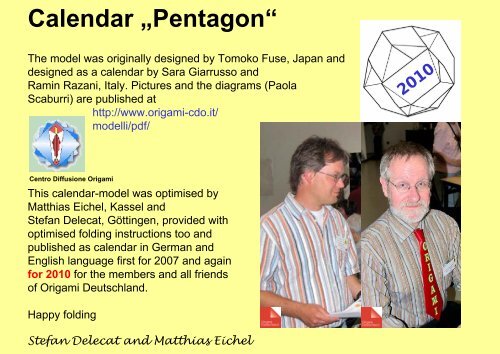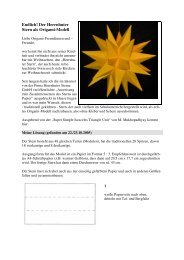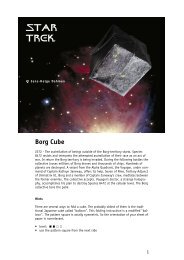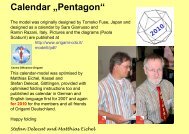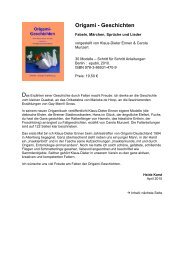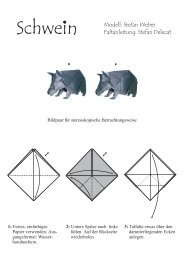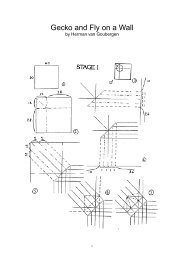Calendar âPentagonâ - Origami Deutschland
Calendar âPentagonâ - Origami Deutschland
Calendar âPentagonâ - Origami Deutschland
You also want an ePaper? Increase the reach of your titles
YUMPU automatically turns print PDFs into web optimized ePapers that Google loves.
<strong>Calendar</strong> „Pentagon“<br />
The model was originally designed by Tomoko Fuse, Japan and<br />
designed as a calendar by Sara Giarrusso and<br />
Ramin Razani, Italy. Pictures and the diagrams (Paola<br />
Scaburri) are published at<br />
http://www.origami-cdo.it/<br />
modelli/pdf/<br />
2010<br />
Centro Diffusione <strong>Origami</strong><br />
This calendar-model was optimised by<br />
Matthias Eichel, Kassel and<br />
Stefan Delecat, Göttingen, provided with<br />
optimised folding instructions too and<br />
published as calendar in German and<br />
English language first for 2007 and again<br />
for 2010 for the members and all friends<br />
of <strong>Origami</strong> <strong>Deutschland</strong>.<br />
Happy folding<br />
Stefan Delecat and Matthias Eichel
January<br />
February<br />
<strong>Origami</strong><br />
<strong>Deutschland</strong><br />
June<br />
<strong>Origami</strong><br />
<strong>Deutschland</strong><br />
October<br />
insert into<br />
Februa r y<br />
unit<br />
insert into<br />
March<br />
unit<br />
June<br />
Oktober
March<br />
April<br />
<strong>Origami</strong><br />
<strong>Deutschland</strong><br />
May<br />
<strong>Origami</strong><br />
<strong>Deutschland</strong><br />
March<br />
insert into<br />
January<br />
unit<br />
inser t in t o<br />
Aug u s t<br />
unit<br />
May<br />
March
May<br />
June<br />
<strong>Origami</strong><br />
<strong>Deutschland</strong><br />
April<br />
<strong>Origami</strong><br />
<strong>Deutschland</strong><br />
November<br />
insert into<br />
December<br />
unit<br />
inse r t i n to<br />
April<br />
un i t<br />
April<br />
November
July<br />
August<br />
<strong>Origami</strong><br />
<strong>Deutschland</strong><br />
September<br />
<strong>Origami</strong><br />
<strong>Deutschland</strong><br />
July<br />
insert into<br />
May<br />
unit<br />
inser t in t o<br />
June<br />
unit<br />
September<br />
July
September<br />
October<br />
<strong>Origami</strong><br />
<strong>Deutschland</strong><br />
August<br />
<strong>Origami</strong><br />
<strong>Deutschland</strong><br />
December<br />
in ser t in t o<br />
inser t in t o<br />
November<br />
unit<br />
O to er<br />
c b<br />
un i t<br />
August<br />
December
November<br />
December<br />
<strong>Origami</strong><br />
<strong>Deutschland</strong><br />
January<br />
<strong>Origami</strong><br />
<strong>Deutschland</strong><br />
February<br />
insert into<br />
September<br />
unit<br />
insert into<br />
July<br />
unit<br />
January<br />
February
on the back<br />
side !<br />
<strong>Calendar</strong> is<br />
on this area<br />
1 2<br />
3a<br />
Both layers<br />
3b<br />
Only top layer<br />
4a<br />
4b<br />
4c<br />
Folding Diagram page 1
5 Mountain fold only bottom layer<br />
6<br />
Mountain fold the existing crease<br />
through all layers<br />
Unit is finished !<br />
Folding Diagram page 2
7a<br />
Put the flap of unit 2 into the pocket of unit 1<br />
Note: The month written on the flap of unit 2 refers to the unit with the imprinted name of this month with expanded font (unit 1)<br />
7b<br />
Put the outer edge of unit 2 to the marking line of unit 1. Fold the supernatant little flaps over and put them into the pockets.<br />
7c<br />
Put the outer edge of unit 1 to the marking line of unit 2. Fold the supernatant little flaps over and put them into the pockets<br />
unit 1<br />
Assembly<br />
7c<br />
7a<br />
7b<br />
unit 2<br />
8<br />
Make 6 of these „duo-units“<br />
9<br />
Put the „duo-units“ together to finish the Pentagon<br />
Note: The advice „put into pocket of month“ means, that the flap of the unit with this advice is put into the pocket of the<br />
unit with imprinted name of the month with expanded font
Suggestion for multi-coloured calendars<br />
Paper with<br />
imprinted name of<br />
the month ...<br />
Coloured<br />
calendar<br />
with 1 colour<br />
Coloured<br />
calendar<br />
with 3 colours<br />
Coloured<br />
calendar<br />
with 6 colours<br />
Coloured<br />
calendar<br />
with 12 colours<br />
March<br />
Colour 1<br />
Colour 1<br />
Colour 1<br />
Colour 1<br />
June<br />
Colour 1<br />
Colour 1<br />
Colour 6<br />
Colour 2<br />
September<br />
Colour 1<br />
Colour 1<br />
Colour 6<br />
Colour 3<br />
December<br />
Colour 1<br />
Colour 1<br />
Colour 1<br />
Colour 4<br />
November<br />
Colour 1<br />
Colour 2<br />
Colour 2<br />
Colour 5<br />
August<br />
Colour 1<br />
Colour 2<br />
Colour 5<br />
Colour 6<br />
May<br />
Colour 1<br />
Colour 2<br />
Colour 5<br />
Colour 7<br />
February<br />
Colour 1<br />
Colour 2<br />
Colour 2<br />
Colour 8<br />
October<br />
Colour 1<br />
Colour 3<br />
Colour 3<br />
Colour 9<br />
January<br />
Colour 1<br />
Colour 3<br />
Colour 4<br />
Colour 10<br />
April<br />
Colour 1<br />
Colour 3<br />
Colour 4<br />
Colour 11<br />
July<br />
Colour 1<br />
Colour 3<br />
Colour 3<br />
Colour 12<br />
Recommendation: Pay attention to sufficient contrast between colour of the<br />
paper and the imprinted calendar, for best result do not use dark paper
C<br />
B<br />
B<br />
A<br />
Background-<br />
Information:<br />
geometrical basis<br />
S<br />
A<br />
For a given regular pentagon with side length<br />
„A“ the size of the square is the following:<br />
The "height" of the Pentagon from the bottom<br />
line up to the broadest place „B“ (1 st parallel<br />
line to the diagonal line of the square) is<br />
duplicated (2 nd parallel line to the diagonal line).<br />
The length of this diagonal line is „A“. On top we<br />
put another right-angled triangle. This entire<br />
construction make up 1/2 of the length of the<br />
diagonal line of the final square.<br />
The side length „S“ of the final square results<br />
as:<br />
S = 2 x<br />
√<br />
(2B + 0,5A)2<br />
2<br />
C<br />
The position of the arrows is:<br />
You take an arrow with length: From an edge of<br />
the square to the beginning of the bottom edge<br />
of the pentagon „C“ and twist it that it starts at<br />
the bottom edge of the pentagon and points<br />
through the meeting point of the 1 st parallel line<br />
with the pentagon. The end of the arrow is the<br />
"magic" point we looked for.


